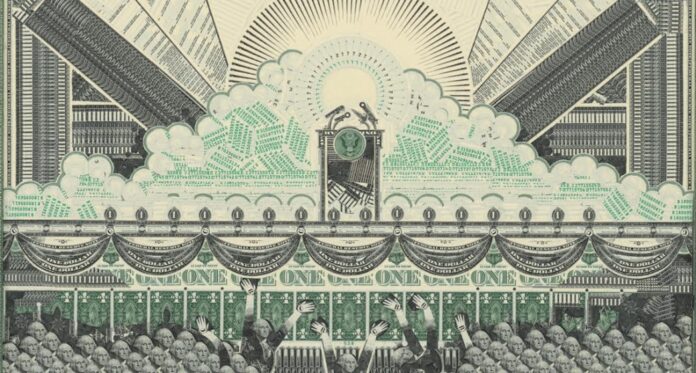Art of the dollar
Money may well have made many a political career but one American artist has now forged his own success crafting politicians themselves out of cold hard cash.
Meticulously handcrafted using small pieces of money – mostly U.S. one-dollar bills – Mark Wagner’s currency collages reconfigure the familiar green and black paper into mythical creatures, fantastical garden scenes, and US politicians past and present.
“The dollar bill is publicly valued, and I like making it privately valuable – or to reflect how rich the person is that I’m depicting,” says Wagner. “A lot of American figures really are made by the U.S. currency.”

Common denominator
Originally a printer and specialist bookbinder who has long dabbled in collage, Wagner first started cutting up dollar bills as material for his art in 1999 after he went looking for the most “common” paper he could find to use for one particular piece.
He soon came to realize the versatility money gave him as a medium, as well as the possibility to explore what money means to people and the essential part it plays in everyone’s life.
“Money means different things to different people, but it’s a subject that everyone is ready to comment on. But when you ask them ‘what is money?’, most people can’t give a good answer and I dress those unknowns into my work,” says Wagner.
Although he uses other types of paper, money has now been Wagner’s primary artistic medium for the last decade and a half, with its texture and multifaceted designs translating well to his unique mosaic style.

Public wealth
His first works were portraits of people – a style he says appeals to him because he likes making a publicly valued asset reflect someone’s private wealth – and he has since expanded his work to include intricately composed scenes of mythological lands and creatures, famous landmarks and statement billboards.
Legal tender
Wagner has worked with other types of U.S. dollar bills and foreign currencies, and while he says he loves the colors and variety they offer, most of his work is now done with the one-dollar bill because of its versatility and abundance.
“I stumbled onto a niche benefit using the one-dollar bill,” he says. “Also, the one dollar is not precious, and because I can get more, I have an infinite supply and don’t get distracted with other possibilities.”
He adds that as it’s the only U.S. currency that hasn’t been redesigned since it was finalized in 1963, it has also kept its “baroque elements” and that the president on it – George Washington, as painted by Gilbert Stuart – is the only one that hasn’t been airbrushed.[McCafferty, Georgia]

Personally, I am typically not a fan of collage-style art pieces but I find Mark Wagner’s dollar bill collages really interesting. The US dollar bill is already a fairly intricate and detailed piece of paper. So to see Mark Wagner take that and create even more intricate patterns I think is really interesting. The artist comments on money and how it means something different to everyone. Money and finances are a very personal thing and there can often be a lot of stress or embarrassment. What can I take away from these art pieces? What can we learn about people’s attitudes and feelings towards finances and how can we use that to inform a design?
McCafferty, Georgia. “Political Portraits Crafted out of Currency.” CNN, Cable News Network, 27 Sept. 2016, www.cnn.com/style/article/mark-wagner-currency-collage/index.html.




